Shure’s microphones have a long-lasting reputation for incredible durability. But how did their designs reach this point, and what goes into their incredible toughness? In this article, we’ll dive into Shure’s history and see what makes a microphone as robust as theirs. If you want a comprehensive guide to all Shure microphones check out our microphone guide here.
The origins of Shure
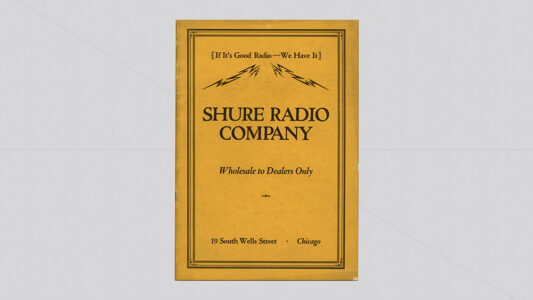 Shure started out as a small radio company based in Chicago in 1925, sending kits and components to customers through the mail.
Shure started out as a small radio company based in Chicago in 1925, sending kits and components to customers through the mail.
By 1928, Shure had grown from a one-man company, operated exclusively by Sidney N. Shure, to a larger headquarters with a fully thriving team.
However, when the Great Depression hit in 1929, the market for home radio kits disappeared in the wake of factory-built radios and economic struggles.
Shure changed their business model and became a distributor for microphone manufacturer Ellis Electrical Laboratories.
After two years of distribution, Shure began developing their first original microphone. They released it the year after, in 1932, and it was known as the Model 33N. The mic’s main advantage was its lightweight construction, making it far more portable than the competing products of the time.
Shure continued to design and build microphones throughout the 1930s, designing early wireless products. However, their main innovation came towards the end of the decade.
The history of dynamic microphones
The moving-coil dynamic microphone capsule was one of the first to be proposed, patented in 1877 by German engineer Ernst Werner von Siemens. This design was built in the 1920s with the Magnetophone by the Marconi-Sykes Company, but it was owned exclusively by the BBC. The first publicly available dynamic microphone was the Model 618A by Western Electric, released in 1931.
How do dynamic microphones work?
Dynamic microphones operate through three main components: a diaphragm, a voice coil, and a magnet. The diaphragm is an extremely light, thin sheet of material, typically some kind of plastic film, that will react to the changes in air pressure caused by sound moving through and making it vibrate slightly.
The vibrations from the diaphragm cause a small coil of wire, the voice coil, to move through a magnetic field. This creates an electrical current, converting motion into electricity. And so, this is how dynamic microphones take the energy of sound and turn it into an electrical current that can be sent through cables, recorded, and played back.
The benefits of dynamic microphones
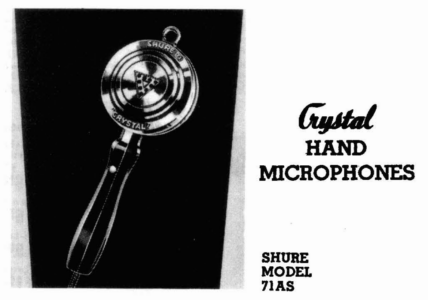 The design of dynamic capsules offers several benefits over the carbon microphones that were more popular at the time.
The design of dynamic capsules offers several benefits over the carbon microphones that were more popular at the time.
Primarily, carbon microphones required large external power supplies to amplify the signal, which limited their usage in many settings.
They also had limited frequency responses, high noise floors, and would distort at high sound pressures.
Overall, dynamic microphones’ higher sound quality, durability, and sound pressure handling made them a dominant alternative to carbon capsules.
Carbon had stopped being used for telephones and early AM radio in the late 1920s, with the rise of vacuum tube amplification taking its place.
However, since vacuum tubes were expensive, carbon was still used as an affordable choice for public address, military communications, and amateur radio throughout the 1930s.
Shure Unidyne Capsule
In 1933, Shure took a huge leap into research and development of microphone technologies. Whilst the Model 33N had been a success, they were intent on innovating to capture the market. Hiring chief engineer Ralph Glover was the first step towards that. The second was hiring Russian-American acoustical development engineer Benjamin Bauer in 1937.
At the time, in order for a microphone to have a cardioid polar pattern, it required two kinds of elements in the same housing: omnidirectional and a figure-eight. These made all dynamic microphones bulky and inconsistent, which was partly why they were so unpopular, despite the drawbacks of carbon designs.
At this point in time, the Magnetophone and the Model 618A were still the only real dynamic offerings on the market.
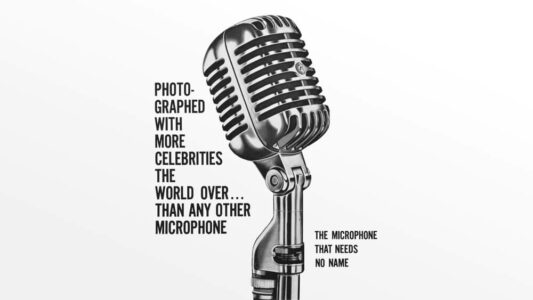 Bauer, however, managed to develop a way of achieving a cardioid polar pattern without having to use two elements at once.
Bauer, however, managed to develop a way of achieving a cardioid polar pattern without having to use two elements at once.
By partially blocking the back side of the microphone’s element, he was able to achieve the same directionality as the omnidirectional and figure-eight, while only needing a single capsule.
The sound then reflected back to the diaphragm and rejected sound from the rear of the microphone.
As a result, this Uniphase technology allowed cardioid, supercardioid, or hypercardioid polar patterns to be created with just one element.
It significantly reduced manufacturing costs, weight, feedback, and noise floor of the microphones, providing consistent sound. Plus, the technology made the most out of the advantages of dynamic microphones.
Uniphase became the backbone of Shure’s Unidyne capsule, which they applied to the Model 55 Unidyne microphones. This marked a radical shift in microphone design techniques, and it’s still felt today. The Model 55 was cheaper, better-sounding, and far more reliable than the competition of the time.
Shure during World War II
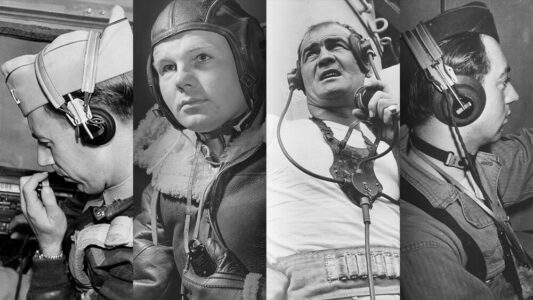 As America entered World War II in December of 1941, demand for Shure’s microphones skyrocketed.
As America entered World War II in December of 1941, demand for Shure’s microphones skyrocketed.
The development of the Unidyne cartridge and the success of the Model 55 caught attention. Their lightweight construction and clearer sound made them a much better option for delivering key communications among Allied forces.
As Shure’s products were distributed through American, British, and Russian forces alike, Shure had to ramp up production. They hired ten times more employees than they had before the war and operated manufacturing lines 24 hours a day.
Shure’s products were so important to the war effort that any Shure employees who volunteered for active duty were turned down!
Controlled reluctance microphones
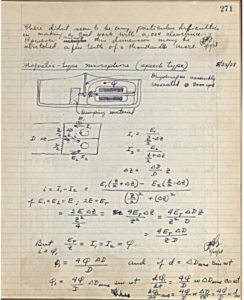
Ben Bauer’s notebook on his controlled reluctance experiments.
Controlled reluctance microphones were a variation on dynamic microphones. The diaphragm connected to a small, metal lever by a drive pin. At the end of the lever was a stationary coil of wire, surrounded by a stationary magnet. As the lever was moved by the diaphragm, it disturbed the magnet’s field, inducing a current.
Fresh off the development of the Unidyne capsule, Ben Bauer wasn’t finished there.
With the huge demand came a technical conundrum. Carbon microphones were extremely tough, capable of withstanding the high pressures that came from the weapons of war – but they were difficult to hear clearly, making miscommunication easy at crucial points.
Even though they provided better sound quality, controlled reluctance microphones couldn’t handle the sound pressures on the battlefield.
An investigation into controlled reluctance microphones
Bauer began investigating controlled reluctance microphones and what was causing their failure under high pressure.
Testing microphones by placing them next to firing naval cannons, Ben found that high sound pressures were snapping the drive pin.
He eventually discovered that a spring would react better to the high sound pressures. It would behave identically to a drive pin during the low pressure of speech, but compress temporarily under high pressures and then return to its original position.
While documentation from the time is limited, Shure has found proof that at least some of these spring-loaded controlled reluctance microphones made it out to the Allied forces.
However, it’s believed that the number shipped is low, as there’s no proof of these models within Shure’s product catalogues released during wartime.
This technology was released to the public by 1949 in the form of the Model 520 Green Bullet.
The microphone quickly became a standard microphone for blues harmonicas thanks to its heavily saturated mid-range, which helped the instrument cut through dense live mixes.
The legacy of controlled reluctance
Surprisingly, this research still impacts listening today. Balanced armature drivers found in many Shure’s SE325, SE425, and SE846 in-ear monitors utilise the same design as Bauer’s controlled reluctance research.
These drivers have remained the gold standard for personal listening to this day. Without Bauer’s research during World War II, modern earphone technology may not have been the same.
Military standards: then and now
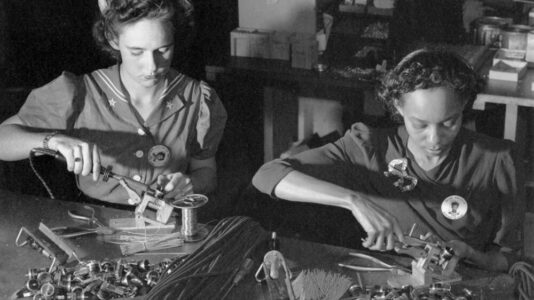 Sidney Shure certainly felt the pressure of wartime demand on the manufacturing standards of his microphones.
Sidney Shure certainly felt the pressure of wartime demand on the manufacturing standards of his microphones.
Whilst production and employment were hugely ramped up, Shure also adopted strict military specifications in 1942 to ensure their microphones were reliable on the battlefield.
A memo sent throughout the company by Shure himself read, “those screws, washers, and other small parts mean the difference between life and death to millions of fighting men in the widespread battle lines of the Allied Forces.”
With the conclusion of World War II, Shure decided to keep building to military specifications.
The company found that even during peacetime, keeping these quality standards resulted in lower scrap rates during manufacturing, fewer returns for repair, and better overall reliability. This has carried on to this very day.
Unidyne III and the SM58
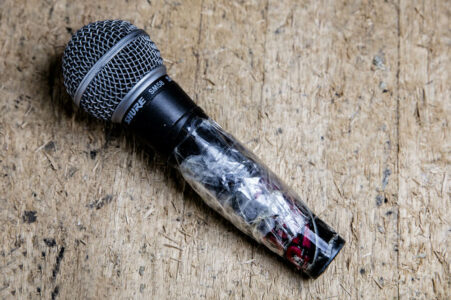 The Unidyne III capsule arrived in 1959, as part of the Model 545 microphone. Its end-firing design gave it a more uniform polar pattern. This meant that it could get even louder before feedback crept in and it could handle higher sound pressures than any previous microphone.
The Unidyne III capsule arrived in 1959, as part of the Model 545 microphone. Its end-firing design gave it a more uniform polar pattern. This meant that it could get even louder before feedback crept in and it could handle higher sound pressures than any previous microphone.
Combined with the smoother mid-range frequency response from the Unidyne II, this helped to set it apart while still using the same core design theory as the Unidyne I capsule.
Shure engineer Ernie Seeler tweaked this cartridge throughout the early 1960s, making prototypes with different diaphragms, voice coils, and magnets in combination. These prototypes underwent a wide range of intensive testing.
Subjecting the models to sudden changes in extreme temperatures, harsh drops, deep water, and loud screaming at close proximity meant that this retuned version of the Unidyne III was tested in every possible way.
These experiments would go on to form the basis of Shure’s next most famous microphones after the Model 55: the SM57 and SM58. They also inspired Shure’s development team to continue developing the most rugged microphones on the market.
Is the SM58 really that tough?
 The short answer is – absolutely! Stories of the SM58 surviving intense drops, incredibly loud performances from punk and rock legends, being run over by cars or buses, and even being set on fire are easy to come by.
The short answer is – absolutely! Stories of the SM58 surviving intense drops, incredibly loud performances from punk and rock legends, being run over by cars or buses, and even being set on fire are easy to come by.
Industry giants like Henry Rollins, Roger Daltrey, Frank Carter, Patti Smith, and Paul McCartney all vouch for this microphone for their live performances. Plus, producers like Sylvia Massy and Rick Rubin maintain that this is the toughest microphone in their vast collections.
There’s a good reason why you see the SM58 everywhere, from festival stages to small DIY rock, punk, and metal venues. They can really take a beating!
Shure maintain this standard of reliability and durability, even applying many of the SM58 prototypes tests on their new designs for condenser microphones.
The Shure microphone tests
Shure have designed a gauntlet of tests which push all their microphones to their absolute limits. These ensure reliable performance, and they mimic the tests Seeler put the SM58 through during the 1960s.
 Drop test
Drop test
Every Shure microphone is dropped at least ten times onto a wooden platform from six feet high. This platform is chosen to replicate the floor of an average live stage, making sure they can survive drops mid-performance without missing a beat.
Much like the front of a car, the ball grille of the SM58 is designed to dent upon impact, absorbing the shock to prevent damage to any of the other components. This is why we sell replacement grilles readily, and many touring musicians will bring a few spares with them.
Sweat test
The stage can be an extremely warm place, and the intensity of performance is bound to create at least a little sweat.
Moisture can easily seep into the microphone, damaging electrical connections, switches, and paint.
So, to make sure their microphones hold up, Shure have developed a synthetic sweat solution that they bathe a product in for up to 48 hours. As unpleasant as that sounds, the results are hard to argue with.
Temperature test
Temperature fluctuations are natural, but testing the extremes is the best way to ensure a microphone can handle the pressure. Placed in chambers that vary from -100°C to extremely high temperatures, Shure microphones are tested to the very limits. Their designs have to pass this test
HALT Chamber
The HALT (Highly Accelerated Life Test Chamber) is designed to test the repeated use of a microphone over time. A build-up of scrapes, bumps, and damage is inevitable. This process lets Shure’s engineering teams analyse what parts of the microphone break first and potentially come up with ways to improve their existing design for a longer life.
Anechoic Chamber
The final test in Shure’s legendary gauntlet is checking the sound performance of a microphone in an anechoic chamber. A completely dead acoustic space, this chamber means Shure can really hear the sounds of their designs without any distractions, noises, or echoes.
Find out more
Shure have innovated and pushed boundaries since their inception. But one thing remains the same: the incredible toughness, reliability, and long-term usability of their microphones.
Keeping to the strict production standards of the military has resulted in industry-leading products at home, on stages, and in studios the world over. If you need robust microphones for travelling production, intense or experimental studio work, or live music, you can’t go wrong with Shure.
Want to know more about the story of Shure? Check out our articles on the history of the SM58 and Unidyne microphone technology!
Intrigued by what we’ve discussed here, and want to see the products behind the research? Why not browse our range of Shure microphones and see which ones suit your needs?

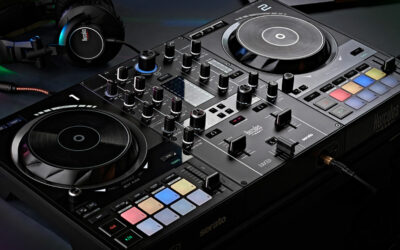
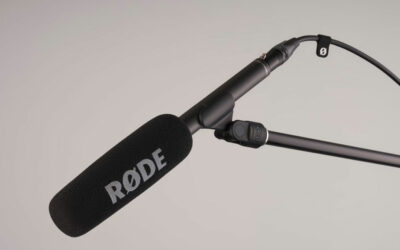


I have a 60’s shure sm58 high impedance the cable joining the microphone is different from today’s microphones can I still get the old fitting ??
Hi Shane,
Thanks for the question, I’m afraid you can’t get the old fitting from the 60’s SM58s new anymore. I believe that these parts aren’t made anymore, so retailers like us don’t stock it.
However, you might be able to get it second-hand! I’d recommend having a look at some vintage auction places – eBay, Reverb, and perhaps Soundgas or some similar vintage mic shops online might have what you need.
Hope this helps, and best of luck in finding the parts you need!
Thanks,
Callum
Very informative loved all the history of shure